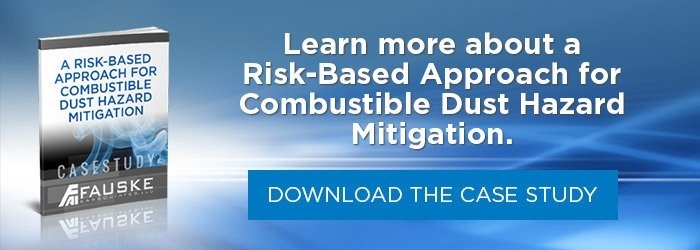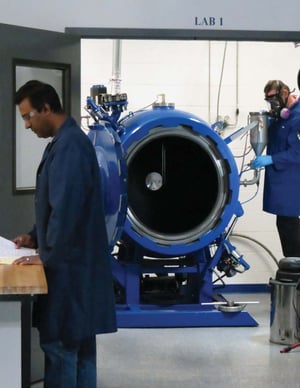 |
|
1 Cubic Meter Chamber at Fauske & Associates
- 1 of very few in the United States
|
We often write about dust hazards analysis testing (DHA), combustible dust control, flammability, thermal hazards and other process safety topics effecting every industry. Over the last month, I noticed 480 internet searches for "DHA laboratories". Makes sense, as 80% of industrial dusts are combustible. Of additional concern, however, a quick search shows there are a plethora of new companies popping up that are actually small labs or 3rd party vendors who broker testing.
While brokering dust testing and consulting makes sense when done in tandem with the purchase of dust collection equipment, for example, we urge precaution in understanding the "why" and "how" a full service DHA testing lab is essential.
Combustible dust hazards gained additional exposure due to the OSHA Combustible Dust National Emphasis Program (NEP) which was re-issued as a result of the fatal accident at Imperial Sugar. Few labs offer a full range of services related to characterizing, preventing and mitigating combustible dust explosion and fire hazards. These services include combustible dust testing, onsite assessments, OSHA compliance assistance, audit preparation, training, ignition source evaluation and vent sizing calculations.
When developing mitigation strategies for explosive or combustible dusts, it is important to characterize the hazard risk of the material in question by determining its explosion severity and ignition sensitivity.
Explosion severity data will determine if an explosion hazard exists, and if so, how energetic it may be while ignition sensitivity data will assess the probability of risk based on how the material responds to heat, spark, impact and frictional forces.
Your lab should offer NFPA & OSHA Combustible Dust NEP Testing Services for determination of both explosion severity and ignition sensitivity per ASTM and European EN methods.
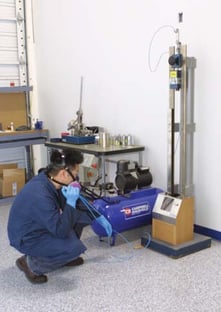 |
| BAM Fallhammer Testing |
Additionally:
• Vent size calculations for new or existing equipment (American and European standards)
• Ignition source evaluation (NFPA 654 and 77)
• Electrical area equipment classification (NFPA 499)
• Integration of combustible dust hazard management into existing process safety programs for process safety management (PSM) facilities
• Process safety program development to manage combustible dust hazards for non-PSM facilities
• On-site Dust Hazard Assessments
• Employee Training to Comply with OSHA Combustible dust NEP requirements
NFPA & OSHA COMBUSTIBLE DUST NEP DHA TESTING SERVICES
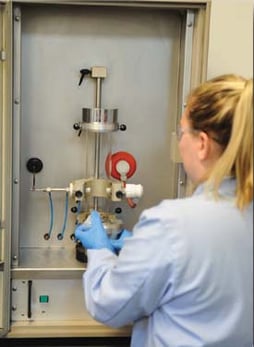 |
MIE Chamber is used to perform Minimum
Ignition Energy of a Dust Cloud in Air |
Explosion Severity Test - (KSt ,PMax and dP/dtMax)
- ASTME 1226 – 2010 - Determines values necessary for designing protective measures, such as deflagration venting
- EN14034 - Part 1:2004 - Determination of the Maximum Explosion Pressure (Pmax) of Dust Clouds – Part 2:2006 - Determination of the Maximum Rate of Explosion Pressure Rise (dP/dtMax ) of Dust Clouds
Minimum Ignition Energy - (MIE)
- ASTM E2019 - Standard Test Method for Minimum Ignition Energy of a Dust Cloud in Air
- EN13821:2002 - Potentially Explosive Atmospheres - Explosive Prevention and Protection - Determination of Minimum Ignition Energy of Dust/Air Mixtures
Minimum Explosible Concentration - (MEC)
- ASTM E1515 - Identifies the Minimum Hazardous Concentration of a Dust Cloud that will Sustain Combustion
- EN14034-3:2006 - Determination of Explosion Characteristics of Dust Clouds - Part 3: Determination of the Lower Explosion Limit (LEL) of Dust Clouds
Minimum Autoignition Temperature of a Dust Cloud - (MIT)
- ASTM E1491 - Determines Safe Operating Temperatures at Which a Dust Cloud Will Not Autoignite
- EN50281-2-1:1999 - Electrical Apparatus for Use in the Presence of Combustible Dust - Part 2-1: Test Methods - Methods for Determining the Minimum Ignition Temperatures of Dust
Hot Surface Ignition Temperature of Dust Layers - (LIT)
- ASTM E2021 - Identifies Dangerous Operating Temperatures at Which a Dust Layer Will Self-Heat
- EN50281-2:1999 - Electrical Apparatus for Use in the Presence of Combustible Dust - Part 2-1: Test Methods - Methods for Determining the Minimum Ignition Temperatures of Dust
Limiting Oxygen Concentration - (LOC)
- Defines Safe Nitrogen Inerting Levels to Prevent Dust Cloud Explosion
- EN14034-4:2004 - Determination of Explosion Characteristics of Dust Clouds - Part 4: Determination of the Limiting Oxygen Concentration LOC of Dust Clouds
Testing is completed on-site in our state of the art dust testing facility per ISO 17025 guidelines.
The state of the art combustible dust testing lab at Fauske & Associates, features one of only a few 1 Cubic Meter Chambers in the United States as part of its comprehensive Dust Hazard Analysis (DHA) services. The Cubic Meter Chamber (1m3) can be used to verify testing results from the smaller 20L chamber. The smaller size of the 20L chamber may sometimes result in what is called, “overdriving.” This is a result of the material coming in contact with the ignition source in the 20L chamber. The Cubic Meter Chamber is not susceptible to overdriving due to its size. The rule of thumb is to consider testing in the 1m3 when your KSt is below 50.
Keep in mind, the amount of sample needed to conduct a test in this chamber is much larger than the standard 20L chamber. Some of the tests need at least 20-30 lbs. of usable sample to complete a series of tests in the 1m3. These are generally sent to our lab in 50 lb barrels. Tests that can be performed in the 1m3 are the Explosibility Screening Test or Challenge Test, Explosion Severity Tests - KSt Pmax, Minimum Explosibiity Concentration (MEC) and Limiting Oxygen Concentration (LOC) of your material.
ON-SITE DUST HAZARD ASSESSMENTS (DHA)
FAI's combustible dust experts can visit your facility to evaluate your receiving, storage, use, processing and disposal of all “powder” materials. They will evaluate existing dust management programs, handling practices, equipment, fire/explosion suppression systems, warning devices and onsite extinguishing capabilities. Possibilities for fugitive dust control will also be identified where appropriate. FAI can provide the following services:
- Incident investigation for dust explosions and fires
- Evaluate compliance with relevant national, local and industry standards
- Electrostatic hazards – e.g. grounding and bonding issues
- Recommendations for explosion hazard risk reduction
- Identify dust sampling points and collect samples for dust explosibility testing
NFPA and OSHA NEP Combustible Dust Compliance
- Preparation for an OSHA Combustible Dust NEP inspection, including appropriate responses to inspector’s questions
- Perform a Process Hazard Analysis (PHA) for compliance with NFPA
- Documentation review for NFPA and OSHA Combustible Dust NEP requirements
- Testing services to meet all NFPA and OSHA Combustible Dust NEP requirements
- Conduct employee training to comply with OSHA Combustible Dust NEP requirements
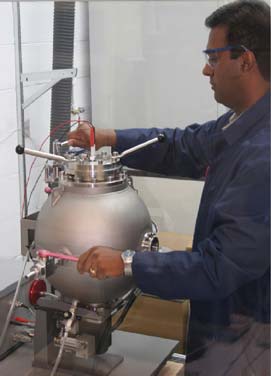 |
| Test performed in 20-L Chamber |
Additional Services
- Vent size calculations for new or existing equipment (American and European standards)
- Ignition source evaluation (NFPA 654 and 77)
- Electrical area equipment classification (NFPA 499)
- Integration of combustible dust hazard management into existing process safety programs for process safety management (PSM) facilities
Development of process safety programs to manage combustible dust hazards for non-PSM facilities
TRAINING
Our team is happy to help train your staff in the understanding of technical issues, process safety programs or audits, regulations and more. We perform process safety audits as part of a comprehensive hazards analysis and can work with you to make sure your staff is supplied with skills training needs in many ways including:
Level I - Gap Analysis
Level II - training & consulting
Level III - Program Development and Implementation
Partial List of Services Offered:
• Reviews and upgrades of all your safety process systems and regulatory requirements
• VPP Consulting
• Audits, reviews, and upgrades of all your Operating, Safety, and Maintenance Procedures
• Training program evaluations for both completeness and effectiveness (from technical skills to professional development) and upgrades where needed
• Reviews and upgrades of your program elements such as Employee Participation and Process Safety Information for effectiveness and completeness
• Work process effectiveness evaluations and upgrades
• Overall organizational development (e.g., motivation, work processes)
• Stress reduction
• Evaluations of the effectiveness of communication
We design, custom develop and deliver any site specific training materials needed by your organization. Our consultants, engineers and technical specialists are available to deliver the classroom, lab or on-the-job training your staff needs. In addition, we will assist with the identification and procurement of commercially available training materials where available.
So, if you Duck, Duck, Go (or, Google) a "DHS Laboratory" search, hopefully, you find this as a start. More than a one-stop shop, a comprehensive and state of the art solution by experts in severe accident mitigation.
